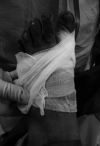Percutaneous Foot Surgery without Osteosynthesis in Hallux Valgus and Outcomes
- PMID: 34026939
- PMCID: PMC8121039
- DOI: 10.22038/abjs.2020.47336.2319
Percutaneous Foot Surgery without Osteosynthesis in Hallux Valgus and Outcomes
Abstract
Background: Several procedures and types of osteotomies have been described for hallux valgus (HV) correction. Percutaneous techniques may lead to an early regain of function reducing morbidity and recovery time. In this study, we aimed to evaluate the clinical and radiographic outcomes of percutaneous hallux valgus (HV) correction.
Methods: One hundred and twenty-four feet treated with the percutaneous technique between May 2011 and December 2015 were included in our study. All patients underwent resection of the medial metatarsal exostosis, complete first metatarsal distal osteotomy, adductor hallucis tendon release and Akin osteotomy of the proximal phalanx. Pre- and postoperative X-rays were clinically assessed.
Results: The mean hallux valgus angle (HVA) and the intermetatarsal angle (IMA) decreased significantly from the preoperative assessment to the final follow-up. The AOFAS score improved from a mean preoperative value of 70.2 to 93.8 at the final follow-up.
Conclusion: Percutaneous complete distal osteotomy in hallux valgus correction is a safe, reliable and effective procedure for the correction of symptomatic mild hallux valgus. Nevertheless, it requires appropriate surgical experience and patient aftercare in order to achieve the best result.
Keywords: Hallux valgus; ercutaneous foot surgery; steosynthesis.
Figures






Similar articles
-
Functional and radiographic outcomes of hallux valgus correction by mini-invasive surgery with Reverdin-Isham and Akin percutaneous osteotomies: a longitudinal prospective study with a 48-month follow-up.J Orthop Surg Res. 2016 Dec 5;11(1):157. doi: 10.1186/s13018-016-0491-x. J Orthop Surg Res. 2016. PMID: 27919259 Free PMC article.
-
Hallux valgus correction with a new percutaneous distal osteotomy: Surgical technique and medium term outcomes.Foot Ankle Surg. 2020 Jan;26(1):39-46. doi: 10.1016/j.fas.2018.11.003. Epub 2018 Nov 14. Foot Ankle Surg. 2020. PMID: 30503613
-
Proximal reverse chevron metatarsal osteotomy, lateral soft tissue release, and akin osteotomy through a single medial incision for hallux valgus.Foot Ankle Int. 2014 Apr;35(4):368-73. doi: 10.1177/1071100713517099. Epub 2013 Dec 18. Foot Ankle Int. 2014. PMID: 24351657
-
Percutaneous distal metatarsal osteotomy for correction of hallux valgus. Surgical technique.J Bone Joint Surg Am. 2006 Mar;88 Suppl 1 Pt 1:135-48. doi: 10.2106/JBJS.E.00897. J Bone Joint Surg Am. 2006. PMID: 16510807 Review.
-
A Systematic Review of Open and Minimally Invasive Surgery for Treating Recurrent Hallux Valgus.Surg J (N Y). 2022 Dec 21;8(4):e350-e356. doi: 10.1055/s-0042-1759812. eCollection 2022 Oct. Surg J (N Y). 2022. PMID: 36568477 Free PMC article. Review.
Cited by
-
Pre- and Post-Operative Relationship between Radiological Measures and Clinical Outcomes in Women with Hallux Valgus.J Clin Med. 2022 Jun 23;11(13):3626. doi: 10.3390/jcm11133626. J Clin Med. 2022. PMID: 35806910 Free PMC article.
-
Temporal Changes in Clinical Outcomes after Minimally Invasive Surgery for Hallux Valgus Correction in Women without Postoperative Complications.J Clin Med. 2023 Jun 28;12(13):4368. doi: 10.3390/jcm12134368. J Clin Med. 2023. PMID: 37445403 Free PMC article.
-
Minimally Invasive vs Open First Metatarsophalangeal Joint Cheilectomy: Radiographic Outcomes and Early Complications.Arch Bone Jt Surg. 2025;13(3):152-156. doi: 10.22038/ABJS.2024.81570.3715. Arch Bone Jt Surg. 2025. PMID: 40151582 Free PMC article.
-
Zigzag tenotomy of the extensor hallucis longus through minimally invasive surgery in cadaveric specimens: description of a new technique.BMC Musculoskelet Disord. 2024 Oct 4;25(1):784. doi: 10.1186/s12891-024-07885-1. BMC Musculoskelet Disord. 2024. PMID: 39367372 Free PMC article.
References
-
- Mann RA, Coughlin MJ. Hallux valgus--etiology, anatomy, treatment and surgical con-siderations. Clin Orthop Relat Res. 1981;(157):31–41. - PubMed
-
- Brogan K, Voller T, Gee C, Borbely T, Palmer S. Third-generation minimally invasive correction of hallux valgus: technique and early outcomes. Int Orthop. 2014;38(10):2115–21. - PubMed
-
- Baravarian B, Briskin GB, Burns P. Lapidus bunione-ctomy: arthrodesis of the first metatarsocunieform joint. Clinics in podiatric medicine and surgery. 2004;21(1):97–111. - PubMed
-
- Richardson EG. Foot in adolescent and adults. In: Crenshaw AH, editor. Campbell’s operative orthopedics. vol 2. St Louis: Mosbyjems; 1992. pp. 829–988.
-
- Trnka HJ. Osteotomies for hallux valgus correction. Foot Ankle Clin. 2005;10(1):15–33. - PubMed
LinkOut - more resources
Full Text Sources
